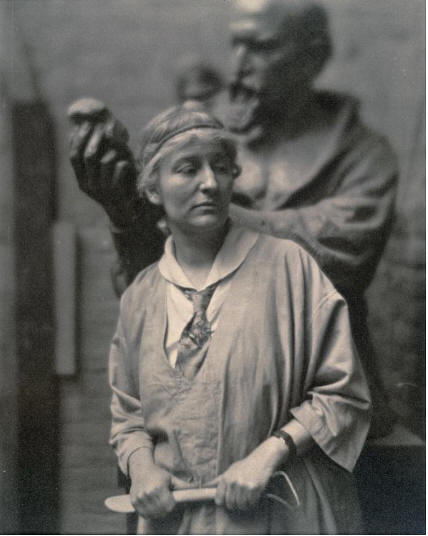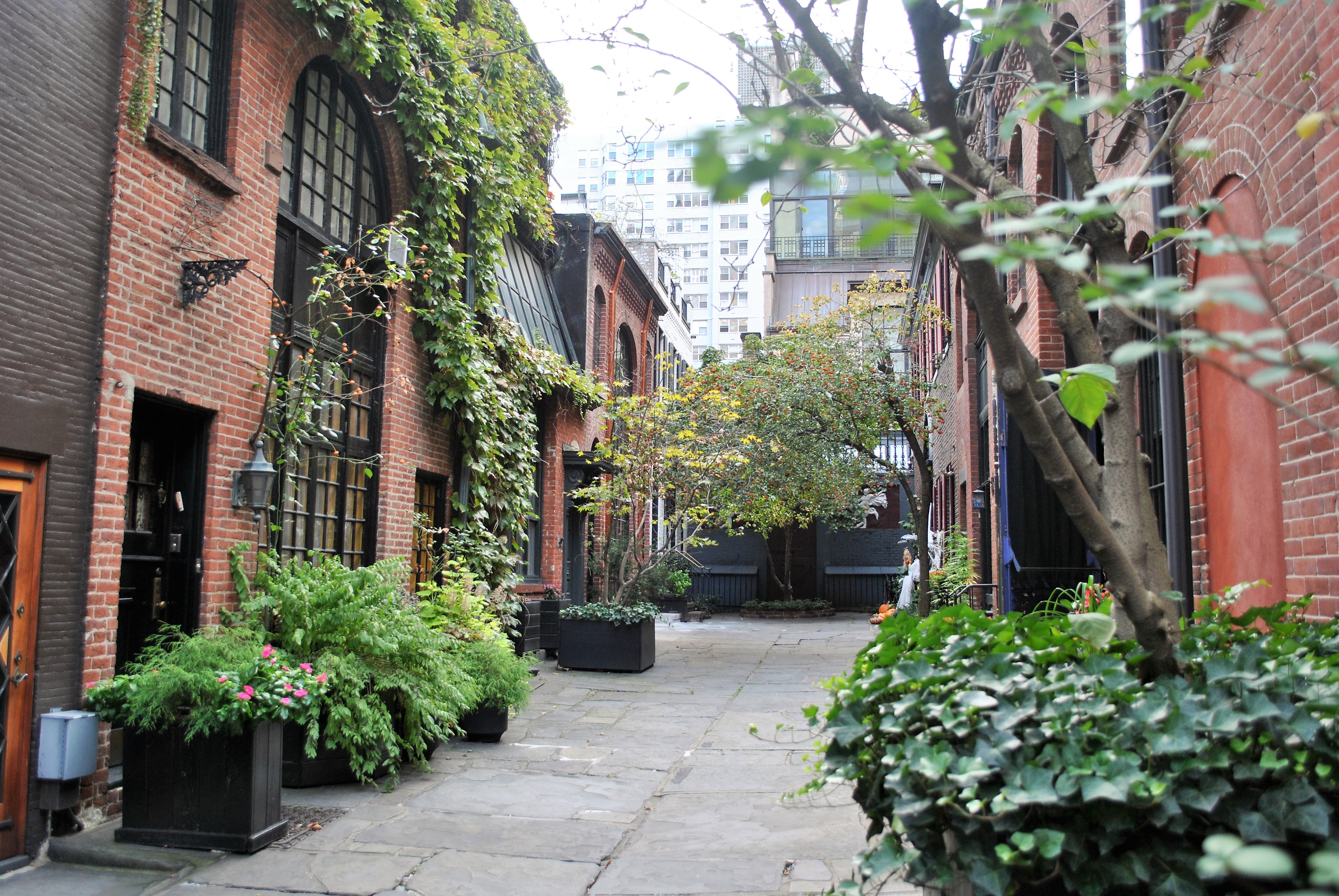Queer Places:
The Art Students League of New York, 215 W 57th St, New York, NY 10019
Sniffen Court, 157 E 35th St, New York, NY 10016
Académie Colarossi, 10 Rue de la Grande Chaumière, 75006 Paris, France
Woodlawn Cemetery, 4199 Webster Ave, Bronx, NY 10470
 Malvina Cornell Hoffman (June 15, 1885 – July 10, 1966)[a]
was an American sculptor and author, well known for her life-size bronze
sculptures of people. She also worked in plaster and marble. In her 1960
autobiography, Here Lies the Heart,
Mercedes De Acosta claimed
to have been intimate with
Isadora Duncan,
Marlene Dietrich,
Alice B. Toklas,
Marie Laurencin,
Eva Le Gallienne, Malvina Hoffman
and
Greta Garbo.
Malvina Cornell Hoffman (June 15, 1885 – July 10, 1966)[a]
was an American sculptor and author, well known for her life-size bronze
sculptures of people. She also worked in plaster and marble. In her 1960
autobiography, Here Lies the Heart,
Mercedes De Acosta claimed
to have been intimate with
Isadora Duncan,
Marlene Dietrich,
Alice B. Toklas,
Marie Laurencin,
Eva Le Gallienne, Malvina Hoffman
and
Greta Garbo.
Hoffman created
portrait busts of working-class people and significant individuals. She was
particularly known for her sculptures of dancers, such as Anna Pavlova.[1][6]
Her sculptures of culturally diverse people, entitled "Hall of the Races of
Mankind", was a popular permanent exhibition at the Field Museum of Natural
History in Chicago.[7]
It was featured at the Century of Progress International Exposition at the
Chicago World's Fair of 1933.[8]
She was commissioned to execute commemorative monuments and was awarded
many prizes and honors, including a membership to the National Sculpture
Society. In 1925, she was elected into the National Academy of Design as an
Associate member and became a full Academician in 1931.[9]
Many of her portraits of individuals are among the collection of the New York
Historical Society. She maintained a salon, a social gathering of artistic and
personal acquaintances, at her Sniffen Court studio for many years.[9]
In 1928 Clara Sipprell took a
portrait of Hoffman.
She was highly skilled in foundry techniques, often casting her own works.[8]
Hoffman published a definite work on historical and technical aspects of
bronze casting, Sculpture Inside and Out, in 1939.[8][9]

by
Arnold Genthe
Malvina Hoffman was born in New York City, the fourth of six children of
the concert pianist and composer, Richard Hoffman, and Fidelia Marshall
(Lamson) Hoffman.[1][3]
She was named after a maternal aunt, Malvina Helen (Lamson) Cornell, who would
later survive the sinking of the RMS Titanic. Her mother, also a
pianist, presided over her education at home until she was 10 years of age.[1][2]
The Hoffman's regularly entertained artists and musicians in their home.[1]
As a young girl, she met Swami Vivekananda when he lived and taught in New
York City, and several of her later sculptures, like that of Sri Ramakrishna,
are located at the Ramakrishna-Vivekananda Center of New York.[10][b]
Hoffman attended Veltin School for Girls,[9]
Chapin, and Brearley private schools.[1]
While at Brearley, she took evening classes at the Woman's School for Applied
Design and the Art Students League of New York.[1]

Sniffen Court
She studied painting with John White Alexander in 1906,[1][9]
and also with Harper Pennington.[1]
Hoffman developed her skill as an artist during her studies with
George Grey
Barnard, Herbert Adams, and Gutzon Borglum.[1][9]
She worked as an assistant to sculptor Alexander Phimister Proctor at his
MacDougal Street studio in Greenwich Village in 1907.[12]
In 1908, Hoffman traveled to Paris with Katharine Rhoades and Marion H.
Beckett and studied art there.[13]
She made a bust of her father, her first finished sculpture, in 1909, two
weeks prior to his death. It was exhibited at the National Academy the
following year.[2][9]
Also in 1910, she won an honorable mention for a sculpture of her future
husband, Samuel Grimson, at the Paris Salon.[3]
Hoffman gravitated towards sculpture due to the artistic freedom she felt when
creating a three-dimensional work of art.[2]
After her father's death in 1910, Hoffman moved to Europe with her mother.
They first visited London, where they attended the ballet of Alexander
Glazunov's Autumn Bacchanale. Hoffman was inspired by the combination
of motion and control exhibited by Mikhail Mordkin and Anna Pavlova.[1]
Mother and daughter visited Italy before moving to Paris.
She worked as a studio assistant for
Janet Scudder. During
the nights she studied at Académie Colarossi. She studied with Emanuele
Rosales[1]
and after five unsuccessful attempts, she eventually was accepted as a student
by Auguste Rodin.[2][15]
She caught his attention when she quoted a poem that he attempted to remember
by Alfred de Musset.[2]
During their lessons, he advised her, "Do not be afraid of realism".[16]
She made a trip to Manhattan in 1912 to dissect bodies at the College of
Physicians and Surgeons at Columbia University.[1]
From Rosales and Rodin, she learned about bronze casting, chasing, and
finishing at foundries.[3]
The Hoffman women lived in Paris until the outbreak of World War I in 1914.[1]
She was married to an Englishman, Samuel Bonarius Grimson, on June 4, 1924.[3][30]
Grimson was injured by mustard gas and phosgene during World War I, and his
career as a concert violist ended when his hands were crushed during an
accident with a truck during the war. After the war, he collected antique
paintings and instruments. He also invented a tube for a color television.[31]
He traveled with her during her search for authentic indigenous models for the
anthropological series.[8]
Hoffman and Grimson divorced in 1936, some speculated that it was due to an
affair that she had with the ballerina Anna
Pavlova.[30]
He married Bettina Warburg, the daughter of Nina Loeb and Paul Warburg,[31][32]
in 1942. She was 16 years his junior. Grimson died in 1955.[30][31]
Hoffman befriended sculptor
Romaine Brooks,
writer Gertrude Stein,
and ballet dancer Anna
Pavlova. She held costume parties and balls in her studio, which were
reported in the city's society pages.[8]
She often spent the summers in a Hartsdale cottage provided to her by Paul
Warburg.[33]
On July 10, 1966, Malvina Cornell Hoffman died of a heart attack in her
studio in Manhattan,[8]
which had been purchased by the philanthropist
Mary Williamson Averell and provided to Hoffman for a low-priced rent.[33]
Hoffman is also connected with Berenice Abbott.

Metropolitan Museum of Art, NYC

Bush House, London
My published books:


BACK TO HOME PAGE

- https://en.wikipedia.org/wiki/Malvina_Hoffman
 Malvina Cornell Hoffman (June 15, 1885 – July 10, 1966)[a]
was an American sculptor and author, well known for her life-size bronze
sculptures of people. She also worked in plaster and marble. In her 1960
autobiography, Here Lies the Heart,
Mercedes De Acosta claimed
to have been intimate with
Isadora Duncan,
Marlene Dietrich,
Alice B. Toklas,
Marie Laurencin,
Eva Le Gallienne, Malvina Hoffman
and
Greta Garbo.
Malvina Cornell Hoffman (June 15, 1885 – July 10, 1966)[a]
was an American sculptor and author, well known for her life-size bronze
sculptures of people. She also worked in plaster and marble. In her 1960
autobiography, Here Lies the Heart,
Mercedes De Acosta claimed
to have been intimate with
Isadora Duncan,
Marlene Dietrich,
Alice B. Toklas,
Marie Laurencin,
Eva Le Gallienne, Malvina Hoffman
and
Greta Garbo.




